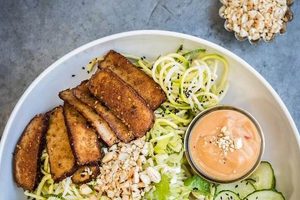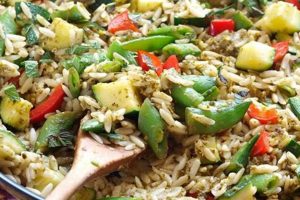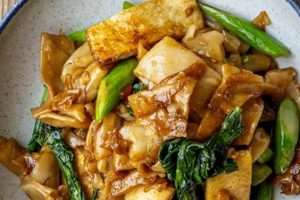The creation of noodle-based dishes devoid of animal products involves understanding both the art and science of dough making. This culinary endeavor necessitates substituting traditional egg-based components with plant-derived alternatives to achieve a similar texture and structural integrity. An example includes utilizing durum wheat semolina or “00” flour combined with water and potentially olive oil or aquafaba to bind the ingredients. The result is a malleable dough suitable for shaping into various pasta forms.
Developing plant-based variations offers several advantages. It caters to individuals adhering to specific dietary restrictions and ethical considerations, like veganism. Furthermore, it broadens the culinary landscape, allowing for experimentation with diverse flours and flavor profiles. Historically, the concept of egg-free pasta isn’t entirely new, with some regional variations traditionally omitting eggs. The current emphasis emphasizes a conscious avoidance of all animal products.
The ensuing discussion will delve into specific ingredient considerations, the preparation process, various shaping techniques, and some suggested sauce pairings to complete the dining experience.
Essential Considerations for Successful Results
Achieving optimal texture and flavor in plant-based variations requires meticulous attention to detail. The following considerations will enhance the outcome of the preparation.
Tip 1: Flour Selection. Durum wheat semolina provides a desirable chewiness. Experiment with “00” flour for a smoother, more delicate consistency. Blending different flour types can yield nuanced textures.
Tip 2: Liquid Ratio. Gradual incorporation of liquid is crucial. Add water (or aquafaba) incrementally, allowing the flour to fully hydrate. Overhydration leads to a sticky, unmanageable dough.
Tip 3: Kneading Technique. Adequate kneading develops gluten, providing structure. Knead the dough vigorously for at least 8-10 minutes. The dough should become smooth and elastic.
Tip 4: Resting Period. Allowing the dough to rest is essential for gluten relaxation. Wrap the dough tightly in plastic wrap and refrigerate for a minimum of 30 minutes. This facilitates easier rolling and shaping.
Tip 5: Rolling and Shaping. When using a pasta machine, start with the widest setting and gradually decrease the thickness. For hand-rolling, maintain a consistent thickness to ensure even cooking.
Tip 6: Drying Considerations. If not cooking immediately, allow the prepared product to dry slightly on a drying rack or a lightly floured surface. This prevents sticking during cooking.
Tip 7: Cooking Time. Fresh preparations cook rapidly. Monitor closely and cook until al dente, typically 2-4 minutes. Avoid overcooking, which results in a mushy texture.
By adhering to these principles, the production of high-quality plant-based noodle dishes becomes more predictable and yields consistently satisfying results.
The concluding section will explore sauce pairings and flavor enhancements to complement the freshly crafted dish.
1. Flour Selection
Flour selection is a foundational element in the creation of plant-based noodle dishes, directly influencing texture, structure, and overall palatability. The absence of eggs, traditionally a binding agent and contributor to elasticity, necessitates careful consideration of flour properties to achieve a satisfactory end product. For instance, durum wheat semolina, characterized by its high protein content, provides a desirable chewiness and firm bite often associated with authentic Italian pasta. Conversely, all-purpose flour, with a lower protein content, may result in a softer, less resilient texture. Therefore, the choice of flour dictates the fundamental characteristics of the finished product.
The impact of flour choice extends beyond texture. Different flours absorb varying amounts of liquid, influencing the hydration balance of the dough. For example, “00” flour, finely milled and possessing a delicate gluten structure, requires precise liquid addition to prevent a sticky, unmanageable dough. Experimentation with flour blends, such as combining semolina with a portion of all-purpose flour, allows for customization of texture and flavor profiles. Additionally, alternative flours, such as those derived from legumes or ancient grains, offer opportunities to create gluten-free or nutritionally enhanced variations, expanding the possibilities for plant-based culinary innovation. However, using these alternatives requires adapting the recipe to account for their unique properties; for instance, some may necessitate additional binding agents like xanthan gum to compensate for the lack of gluten.
In conclusion, proper selection and understanding of flour properties are paramount for successfully crafting plant-based noodle dishes. The interplay between flour type, hydration, and gluten development dictates the final texture and structure, influencing the dining experience. Challenges associated with replicating the properties of egg-based preparations are mitigated by informed flour choices and adjustments to the recipe. Mastering this aspect of noodle preparation provides a solid foundation for exploring the broader spectrum of plant-based cuisine.
2. Hydration balance
Hydration balance represents a critical factor influencing the success of plant-based noodle creation. In the absence of eggs, which contribute moisture and binding properties to traditional preparations, the careful management of liquid content becomes paramount. Insufficient hydration results in a dry, crumbly dough that is difficult to work with and yields a coarse, undesirable final product. Conversely, excessive hydration leads to a sticky, unmanageable dough that clings to surfaces and produces a gummy, unpleasant texture after cooking. The correct water-to-flour ratio, therefore, directly impacts the dough’s workability and the finished noodle’s structural integrity.
Several factors influence the optimal hydration level. Flour type, as previously discussed, plays a significant role, with some flours absorbing more liquid than others. Environmental humidity also affects the dough’s moisture content; in drier climates, a slightly higher liquid ratio may be necessary. Practical application of this understanding involves the gradual addition of liquid, allowing the flour to fully absorb the moisture before adding more. The dough’s texture should be monitored closely, adjusting the liquid content as needed until a smooth, pliable consistency is achieved. For instance, a durum wheat semolina dough typically requires less water than a dough made with all-purpose flour.
Maintaining hydration equilibrium presents a recurring challenge in plant-based noodle making. However, consistent attention to detail and iterative adjustments to the liquid content, based on observed dough texture and environmental conditions, contribute to a more predictable and satisfactory outcome. Ultimately, mastering hydration balance unlocks the potential to create plant-based noodles that replicate the desirable texture and mouthfeel of their egg-based counterparts. This skill is fundamental to vegan pasta-making proficiency and links directly to the broader goal of creating delicious and accessible plant-based alternatives.
3. Gluten development
Gluten development is intrinsically linked to the structural integrity and textural properties of plant-based noodle preparations. In traditional pasta making, gluten, a protein complex formed from glutenin and gliadin when flour is hydrated, provides the elasticity and chewiness characteristic of the finished product. When formulating a version devoid of animal products, specifically eggs, this process becomes even more crucial. The absence of eggs, a binding agent, necessitates heightened attention to gluten network formation to compensate for the lack of structural support. Insufficient gluten development results in a fragile, easily torn dough that yields a brittle, unappetizing product upon cooking. Conversely, optimal gluten development imparts a desirable resilience and prevents the noodles from becoming overly soft or mushy during boiling. Consider, for example, the difference between a poorly kneaded dough that disintegrates during rolling and cooking and one that has been adequately kneaded, demonstrating a smooth, elastic texture suitable for various pasta shapes.
Achieving satisfactory gluten formation in plant-based variations involves several critical factors. First, the selection of high-protein flour, such as durum wheat semolina, provides a greater abundance of gluten-forming proteins. Second, proper hydration is essential; water allows glutenin and gliadin to interact and form the gluten network. Gradual water addition and thorough mixing ensure even hydration. Third, the kneading process is paramount. Kneading aligns the gluten strands, strengthening the network and increasing elasticity. Vigorous kneading for a minimum of 8-10 minutes is generally required. Finally, a resting period allows the gluten to relax, making the dough easier to roll and shape. In practice, this involves wrapping the kneaded dough tightly and refrigerating it for at least 30 minutes. Without sufficient resting time, the dough may be too resistant to rolling, resulting in uneven pasta thickness.
In summary, gluten development is a non-negotiable aspect of crafting superior plant-based noodles. The absence of animal-derived ingredients amplifies the importance of maximizing gluten network formation to provide the necessary structure and texture. Successful gluten development relies on the strategic combination of high-protein flour, controlled hydration, effective kneading, and adequate resting time. Mastery of these techniques addresses challenges associated with replicating traditional pasta characteristics in a plant-based format, leading to improved outcomes in both texture and structural integrity. The practical consequence of this understanding is consistently superior results and a broader range of options for plant-based dining.
4. Resting time
Resting time, an often-overlooked component in culinary processes, plays a crucial role in the successful creation of a palatable plant-based noodle dish. This step, following the kneading phase, facilitates specific biochemical and physical changes within the dough matrix, directly impacting its workability, texture, and final cooked quality. Without adequate resting time, the final product may exhibit undesirable characteristics, regardless of other preparation techniques.
- Gluten Relaxation
After kneading, gluten strands are highly elastic and resistant to stretching. Resting allows these strands to relax, reducing the dough’s internal tension. This relaxation simplifies subsequent rolling and shaping processes, preventing the dough from snapping back or tearing. In the context of a plant-based variation where egg’s structural support is absent, the importance of manageable dough is heightened.
- Hydration Equalization
Kneading, although crucial for gluten development, does not guarantee uniform hydration. Resting provides time for moisture to redistribute throughout the dough mass, ensuring that all flour particles are fully hydrated. Uneven hydration can lead to inconsistencies in texture and cooking time. A well-rested dough exhibits a more homogenous texture and predictable cooking behavior.
- Enzyme Activity
Resting allows naturally occurring enzymes within the flour to act on starches, converting them into simpler sugars. This enzymatic activity enhances flavor and improves browning during cooking. While subtle, these enzymatic changes contribute to the overall palatability of the finished product, offering an enriched flavor profile.
- Improved Texture
The cumulative effect of gluten relaxation, hydration equalization, and enzymatic activity results in a superior final texture. A well-rested dough yields noodles that are tender yet retain their shape during cooking, avoiding a mushy or gummy consistency. This is particularly important for plant-based variations which may be more prone to textural issues without proper preparation.
These multifaceted benefits of resting time directly contribute to the quality of plant-based noodle dishes. The resulting dough is easier to handle, cooks more evenly, and possesses a more desirable texture and flavor. Skipping this step compromises the final outcome, potentially resulting in a less satisfying culinary experience. Therefore, adherence to appropriate resting protocols is an indispensable element in the successful creation of these dishes.
5. Shaping technique
Shaping technique is not merely an aesthetic consideration but an integral component of plant-based noodle creation, directly influencing cooking time, texture, and the overall culinary experience. The absence of eggs necessitates a refined approach to shaping, as the dough’s structure relies solely on gluten development and hydration management. Incorrect shaping can lead to uneven cooking, with thicker portions remaining undercooked while thinner sections become overly soft. For example, poorly formed ravioli may burst during boiling, resulting in a loss of filling and an undesirable texture. Therefore, understanding and employing proper shaping techniques are critical for achieving consistent and palatable results in a plant-based context.
The specific shaping method dictates the surface area to volume ratio of the noodle, which in turn affects the cooking process. Thin strands of spaghetti cook more rapidly than thicker shapes like rigatoni. This distinction is amplified in plant-based preparations, where the dough may be more susceptible to overcooking due to the absence of egg proteins that provide additional structural stability. Furthermore, intricate shapes like farfalle or orecchiette require careful manipulation to ensure that all parts of the noodle cook evenly. This can be accomplished through consistent dough thickness and precise folding or pressing techniques. A pasta machine allows for uniform sheet thickness, enabling consistent shapes, whereas hand-rolling requires greater skill and attention to detail.
Ultimately, shaping technique is inextricably linked to the success of the final dish. Skillful shaping contributes to even cooking, optimal texture, and an enhanced presentation. Mastery of various shaping methods expands the possibilities for plant-based noodle cuisine, allowing for diverse culinary applications and creative presentations. The challenges associated with shaping plant-based dough are mitigated by meticulous attention to detail, practice, and the use of appropriate tools. Considering the influence of shaping, coupled with considerations of flour, gluten, hydration, and resting time, enables the creation of plant-based noodle dishes that meet the highest standards of quality and flavor.
6. Cooking duration
Cooking duration represents a crucial control parameter influencing the final texture and palatability of plant-based noodle dishes. The absence of eggs in the dough formulation modifies its cooking behavior compared to traditional pasta, rendering precise timing essential. An undercooked plant-based noodle may exhibit a gummy, unappetizing texture due to incomplete starch gelatinization. Conversely, an overcooked noodle becomes mushy and loses its structural integrity, resulting in an equally undesirable outcome. Therefore, accurate regulation of cooking duration is paramount for achieving the desired al dente texture. For example, a batch of plant-based ravioli, cooked two minutes beyond the optimal time, may rupture and release its filling, compromising both texture and flavor.
Factors influencing optimal cooking duration include noodle thickness, shape, and the specific flours used in the dough. Thicker noodles, such as pappardelle, require a longer cooking time than thinner strands like angel hair. Similarly, durum wheat semolina tends to maintain its structure better than all-purpose flour, allowing for a slightly longer cooking duration without becoming overly soft. Altitude also impacts cooking time; at higher altitudes, water boils at a lower temperature, requiring extended cooking periods. Monitoring the noodles visually and through tactile assessment is essential. The noodles should be tasted frequently during cooking to determine the precise moment when they achieve the desired al dente texture, characterized by a slight resistance to the bite. A plant-based fettuccine prepared with semolina, for instance, may require only 2-3 minutes of cooking time once it floats to the surface of the boiling water.
In conclusion, careful management of cooking duration is indispensable for creating successful plant-based noodle dishes. The absence of eggs amplifies the sensitivity of the dough to overcooking, necessitating precise timing and frequent assessment. Understanding the factors that influence cooking duration and employing appropriate techniques, such as visual monitoring and tactile assessment, contribute to a consistently superior final product. Addressing the nuances of cooking duration allows for the broader utilization of plant-based noodles across varied culinary applications, delivering texture and flavor profiles that mirror the qualities of traditional preparations.
7. Sauce pairing
The selection of appropriate sauce complements the inherent characteristics of the plant-based noodle dish, transforming individual elements into a cohesive culinary experience. Sauce pairing exerts a direct influence on the perceived flavor, texture, and overall enjoyment of the meal. The absence of eggs in the dough often necessitates a more assertive sauce to provide richness and complexity. A delicate, subtly flavored sauce may be overwhelmed by the relatively neutral flavor of the plant-based noodle. Conversely, a robust and flavorful sauce can elevate the dish, compensating for any perceived lack of depth. Consider, for instance, a creamy cashew-based sauce paired with delicate strands. The sauce provides the richness traditionally associated with cream-based sauces while allowing the noodle’s subtle texture to shine.
The interaction between sauce and noodle extends beyond flavor complementarity. The texture of the sauce also plays a significant role. A smooth, velvety sauce coats the noodles evenly, enhancing the mouthfeel. Chunky sauces, while visually appealing, may not adhere as well, resulting in an uneven distribution of flavor. The sauce’s viscosity is also crucial. A watery sauce dilutes the flavor and fails to create a cohesive bond with the pasta. Conversely, an overly thick sauce can feel heavy and overpowering. Examples of successful pairings include a vibrant pesto made with basil, pine nuts, and plant-based Parmesan cheese served with trofie, or a hearty lentil bolognese sauce blanketing freshly-made tagliatelle. These pairings highlight the potential for complementary flavors and textures that amplify the dining experience.
Effective pairing requires a thorough understanding of both sauce and noodle characteristics. Consideration of the ingredients, cooking methods, and desired flavor profiles is essential. While personal preference undoubtedly plays a role, adherence to established culinary principles often yields the most satisfying results. Mastering this pairing process enables a cook to fully harness the potential of plant-based noodle dishes, broadening the appeal and gastronomic possibilities of this category of cuisine. By carefully considering flavor profiles and textures, the dining experience can be elevated providing a wider spectrum of vegan cuisine offerings.
Frequently Asked Questions
This section addresses common inquiries related to the preparation and characteristics of plant-based noodle dishes, providing concise and informative answers to ensure a clear understanding of the process.
Question 1: What is the primary substitute for eggs in plant-based preparations?
The most common substitute for eggs is water. Aquafaba, the liquid from cooked chickpeas, may also be used to impart a slight binding and emulsifying effect, contributing to texture.
Question 2: Does plant-based pasta require specialized equipment?
No specialized equipment is strictly necessary. Standard pasta-making tools, such as a rolling pin or pasta machine, are sufficient. Hand-rolling is also a viable option.
Question 3: How does the texture of plant-based pasta differ from traditional egg-based pasta?
The texture may be slightly different, generally exhibiting a firmer bite. Proper technique, including kneading and resting, minimizes textural differences. Flour selection impacts this factor significantly.
Question 4: Is gluten-free variation possible?
Yes, gluten-free versions can be crafted using alternative flours, such as rice flour or a blend of gluten-free flours. The recipe requires adjustments to accommodate the lack of gluten. Xanthan gum may improve texture.
Question 5: How does cooking time differ for plant-based pasta?
Cooking time is generally similar to traditional pasta, typically requiring 2-4 minutes once the noodles are added to boiling water. Frequent monitoring ensures optimal al dente texture.
Question 6: What are some suitable sauce pairings for plant-based noodles?
A wide range of sauces complements plant-based noodles. Pesto, marinara, creamy cashew-based sauces, and lentil bolognese are suitable pairings. The key is to select sauces that complement the noodle’s flavor and texture.
These questions and answers provide a fundamental understanding of the process, addressing key considerations and potential challenges associated with these preparations.
The subsequent section will delve into specific recipe formulations, offering practical guidance for creating various types of plant-based noodle dishes.
Vegan Fresh Pasta Recipe
This discourse meticulously examined the creation of a specific culinary item, delving into its ingredient properties, preparation methodologies, and the resulting texture nuances. The influence of flour selection, hydration control, gluten development, resting time, shaping technique, cooking duration, and sauce pairings was thoroughly explored. Each element contributes significantly to the final product’s quality and appeal, underscoring the need for attentive execution.
The development and refinement of plant-based recipes represent a vital response to evolving dietary preferences and ethical considerations. Further exploration and adaptation of these techniques will undoubtedly lead to increased accessibility and acceptance of plant-based cuisine. Dedicated application of these principles will lead to a broader and more refined culinary landscape.







